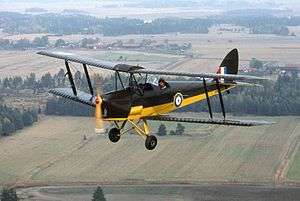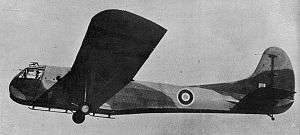No. 669 Squadron RAF
No. 669 Squadron RAF was a glider squadron of the Royal Air Force active during the Second World War.
| No. 669 Squadron RAF | |
|---|---|
| Active | 16 November 1944 – 31 December 1944 1 January 1945 – 10 November 1945 |
| Country | |
| Branch | |
| Role | Glider squadron |
| Part of | No. 229 Group RAF, South East Asia Command[1] |
| Insignia | |
| Squadron Codes | No code(s) known to have been used by this squadron[2][3] |
History
No. 669 Squadron RAF was formed on 16 November 1944 at Bikram, Patna, India[4] as a glider squadron, with the intention of being used for airborne operations by South East Asia Command. However, after a short period it was redesignated No. 671 Squadron RAF, due to an earlier mix-up of squadron designations and bases.[4] The squadron was reformed anew the next day, with the same role and at the right base, and continued to train, as part of No. 343 Wing RAF, until the surrender of Japan, when it became surplus to requirements. The squadron was disbanded on 10 November 1945 at Fatehjang, British India.[4]
Present
The squadron today is represented by 669 Squadron of 9 Regiment, Army Air Corps.

Aircraft operated

| From | To | Aircraft | Variant |
|---|---|---|---|
| November 1944 | December 1944 | Waco Hadrian | |
| June 1945 | July 1945 | Waco Hadrian | |
| July 1945 | November 1945 | de Havilland Tiger Moth | Mk.II |
Squadron bases
| From | To | Base |
|---|---|---|
| 16 November 1944 | 31 December 1944 | Bikram, Bihar, British India |
| 1 January 1945 | 19 March 1945 | Basal, Punjab, British India |
| 19 March 1945 | 27 May 1945 | Belgaum, Karnataka, British India |
| 27 May 1945 | 23 June 1945 | Upper Topa Camp, Punjab, British India |
| 23 June 1945 | 6 July 1945 | Basal, Punjab, British India |
| 6 July 1945 | 10 November 1945 | Fatehjang, Punjab, British India |
References
Notes
- Delve 1994, p. 84
- Bowyer and Rawlings 1979, p. 148.
- Flintham and Thomas 2003, p. 233.
- Halley 1988, p. 452.
- Jefford 2001, pp. 266–271.
Bibliography
- Bowyer, Michael J.F. and John D.R. Rawlings. Squadron Codes, 1937–56. Cambridge, UK: Patrick Stephens Ltd., 1979. ISBN 0-85059-364-6.
- Delve, Ken. The Source Book of the RAF. Shrewsbury, Shropshire, UK: Airlife Publishing, 1994. ISBN 1-85310-451-5.
- Flintham, Vic and Andrew Thomas. Combat Codes: A full explanation and listing of British, Commonwealth and Allied air force unit codes since 1938. Shrewsbury, Shropshire, UK: Airlife Publishing Ltd., 2003. ISBN 1-84037-281-8.
- Halley, James J. The Squadrons of the Royal Air Force & Commonwealth 1918–1988. Tonbridge, Kent, UK: Air Britain (Historians) Ltd., 1988. ISBN 0-85130-164-9.
- Jefford, C.G. RAF Squadrons, a Comprehensive record of the Movement and Equipment of all RAF Squadrons and their Antecedents since 1912. Shrewsbury, Shropshire, UK: Airlife Publishing, 1988 (second edition 2001). ISBN 1-85310-053-6.
- Rawlings, John. Coastal, Support and Special Squadrons of the RAF and their Aircraft. London: Jane's Publishing Company Ltd, 1982. ISBN 0-7106-0187-5.
